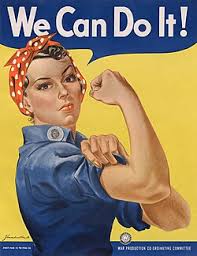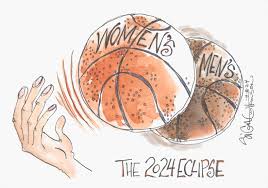1 Chapter One: Sports Feminism
Section One: The Fundamentals
A) What do we know about sport? What are common assumptions we make about sport and society?
Exercise 1: Before we go any further, I want you to take a moment and complete the phrases below:
While these statements might be true on one level, on another, they do not align with many people’s experience of sport, which brings us to our first class discussion forum.
Exercise 2: Padlet response
Speculate on why some of the statements/assumptions above might be untrue for some people or from a certain perspective. Is there anything your peers noted that surprised you? Comment on this as well.
[type below or paste in a screenshot of your padlet participation]
Sport reflects individual merit:
- Although I can see how someone may argue this, it is not entirely true. Many sports that require a team may value their “top players” more than the rest of the team. Top players usually receive more play time, more attention from the media and fans, and get paid more. Although “top players” are important, team sports are team sports for a reason. I believe top players wouldn’t be top players without the rest of the players they play with. One of the sports I watch the most is hockey (NHL), and the team I watch the most is the Toronto Maple Leafs. For this discussion, I will use this team as my example because I know the most about them. On this team, many people argue Auston Matthews is the best player. Auston Matthews has led the team in goals for many seasons, has won many awards, and also broke records last year for scoring more goals than anyone else. You cannot deny that he is an extraordinary hockey player, although I don’t think he could do all of this without his teammates. A player typically cannot score a goal by themselves, thus being the reason the league also awards points for assisting a goal. I would argue that whoever assists the goal is just as important as the player who scores the goal. It is also important to note that a goal and an assist do not just happen, but a play is made for these things to happen. A play typically involves more than two or three players, and sometimes the whole team. Plays, and assists set “top players” up to score goals. My point is, although one player may score a lot the rest of their team also matters.
- My point is that although “top players” get a lot of attention, they wouldn’t be able to achieve the things they do without their teammates. Everyone on a team plays an important and significant role.
|
Exercise 3: Notebook prompt
What are some other metanarratives about sport that you are familiar with? Find an image or video clip or draw something yourself that captures this idea…
So what? Why does any of this matter? Does it matter? As something we grow up with – live with – play through – we don’t often interrogate the meanings of sport, and perhaps we don’t want to.
But being aware of these assumptions and metanarratives is especially important, I would argue, because of the centrality of sport to our everyday lives, the role that sport plays in shaping our childhood and worldviews and….. [finish that thought]
Sport as entertainment and viewed as a business
- Growing up, and sometimes still today I only think of watching sports as a form of entertainment. Sometimes it escapes my mind that professional sports teams such as the NBA, NFL, and NHL are forms of business. This means that players are paid to play, and do not play for the fun of it. Players are also paid to win, winning certain awards comes with financial bonuses. The number of viewers a team and a league get determines aspects such as the salary of a player. Finally, athletes are able to do sponsorships with other companies to not only bring more attention to a certain company but to also earn money as individual athletes. A commercial I can think of that has been playing recently is Connor McDavid and Auston Matthews promoting McDonald’s within a commercial.
So what?
- One of the main reasons I think it matters that professional sports are a business is because there is a point where sport turns from “fun” to “serious”. As someone who played recreational sports, and moved into competitive sports in my early teen years I was able to see this firsthand. Playing recreational sports was all about having fun, so much so that the score was not kept track of and everyone got a participation trophy. When I started playing competitive sports I noticed a shift, where many players and their parents were a lot more focused on the game, their individual development, as well as the team’s success/winning. When I noticed this as a child, I felt like it made playing the sport I loved less fun, and I could feel the pressure of other parents.
- Although I never wanted to take my sport to a professional level, I can only imagine the seriousness at this level of sport. I think when you are a professional, the level of fun in sports disappears.
- The reason why I think this matters is because as a kid, the meaning of sport is to have fun and enjoy playing. Whereas when you get older I feel that sport loses this meaning.
|
B) What is social justice?
Exercise 4: Padlet Prompt
Think back to the last section and try to look at some of the ideas we discussed differently. How might sport and social justice actually co-exist?
Record any images, video clips, or gifs you added to the padlet and identify a point of intersection between sport and social justice (can be an issue or a barrier or a debate or something you would like to explore in more depth in this course) . Screenshot or paste in your response below.
Advocacy and Activism
- I believe that sports can connect with advocacy and activism. This is because I have seen many sports teams as well as individual athletes stand up for what they believe in while practicing their sport. An example of this may be from the years of 2016-2020 I watched some of my favourite athletes kneel during a national anthem being played. The reason many athletes did this was to protest against systemic racism in the United States while the U.S.A. anthem played. As someone who watches quite a few sports, while any anthem plays the TV crew usually gives viewers a look at many athletes during this time. Thus being a great time for athletes to capture the audience’s attention.
- An example of an athlete kneeling during the anthem is Colin Kaepernick, an NFL quarterback who at the time played for the San Fransisco 49ers. This took place on December 18, 2016, when the 49ers were set to face the Atlanta Falcons.
|
C) Social Justice Reading
(note: this activity is optional!)
D) KINESIOLOGY AND SOCIAL JUSTICE
Exercise 5:
Exercise 6:
What are the implications of bodies-at-risk discourse and the refusal to understand the health gap from a social justice perspective, according to the authors of this article?
- One of the perspectives I found according to the authors of this article was a “blame the victim orientation”. Blaming the victim can happen in many settings, in this instance, it has to do with health but can also come into play when dealing with sexual assault cases. Blaming the victims is what it is called, it is about blaming the victim for their circumstances. In the context of these authors, points of intersectionality are taken into consideration to blame the victim for their health and kinesiology.
- Health inequity is another important aspect of this article. Intersectionality can affect many things in an individual’s life such as their environmental, social, or economic way of life and/or disadvantages. These aspects can have an effect on an individual’s health and well-being: for example, an individual who comes from a poorer community may not have the funds for things such as healthy foods, access to healthcare, or a way to spend leisure time.
|
Section Two: Sport Feminism
Exercise 7: Notebook Prompt
What is feminism? What does it mean to you? Choose one of the images below and explain how it captures your understanding of feminism (or find one that does speak to you and paste this into your pressbook with an explanation of why it matters to you.
- In my opinion, feminism means to stand up for injustices women have faced through history, and still face to this day. When I think about feminism, I think about all the feminists who came before me and fought for my rights to vote, work, have an abortion, etc. Feminism, in my opinion, requires resistance. I say this because women have heard the word “no” many times, and we still get back up and keep fighting.
- I chose this picture below because I think it defies some common stigmas and stereotypes about women. The stereotypical woman has long hair, does not have muscles, wears something more feminine such as a dress, and is quiet. I like how the woman in this image seems confident, I think confidence is something that many women have to fight to have due to historical events. I also like how she is flexing her arm, I think in today’s society many people think that men are the only ones who should have muscles, which is completely not true. Another thing I like about the woman in this picture is her appearance. I think many people believe for a woman to be labelled as pretty, they need to conform to societal pressures of appearance that I previously claimed (long hair, wearing makeup, dressing feminine). I like how the woman in this picture is wearing what she feels comfortable in and is still confident.
- All in all, when I think about feminism these are some of the characteristics I think about:
- Confident
- Resilliant
- Loud and proud
- Courageous
- Passionate
- Fearless
- Bold

|
Exercise 8: Notes Prompt (optional)
NB: Cornell notes is a great resource that teaches effective notetaking. Unfortunately, our system can’t save notes taken in the H5P app, so this is fully optional.
Exercise 9: Crossword Activity
Exercise 10: Padlet Prompt
Create your own word cloud including all of the important terms and concepts covered in the article that were not included in the crossword activity! (Record or screenshot your response below).
Exercise 11: Padlet Discussion Prompt (optional)
The illustration featured in this padlet (of a basketball with the word “women’s” eclipsing a basketball bearing the word “men’s” at the time of the solar eclipse) ran last year in a Philadelphia newspaper piece about how athletes like Angel Reese and Caitlin Clark were generating unprecedented enthusiasm for women’s sport. Do you feel the landscape is changing? Do people care about women’s sport?




